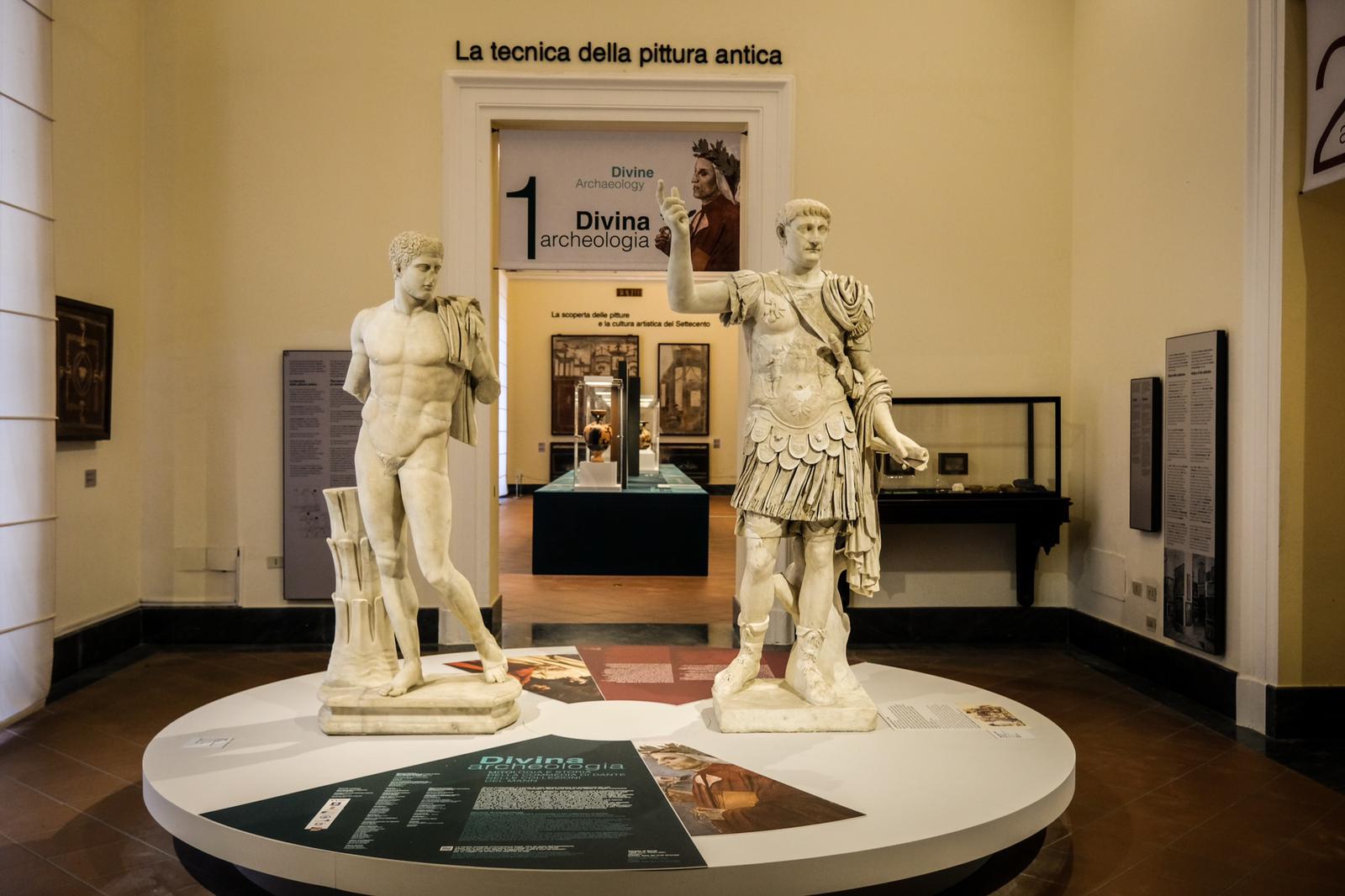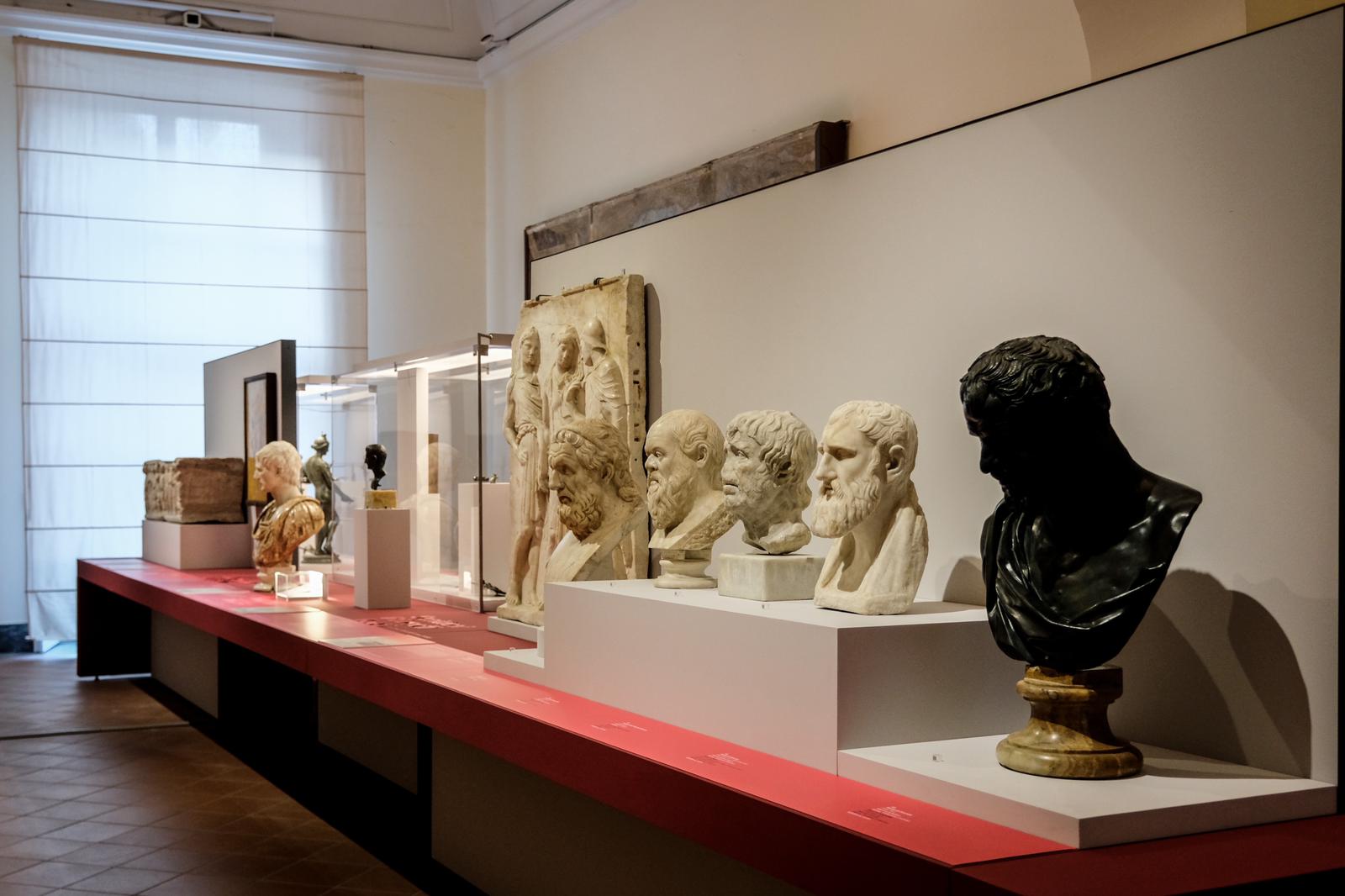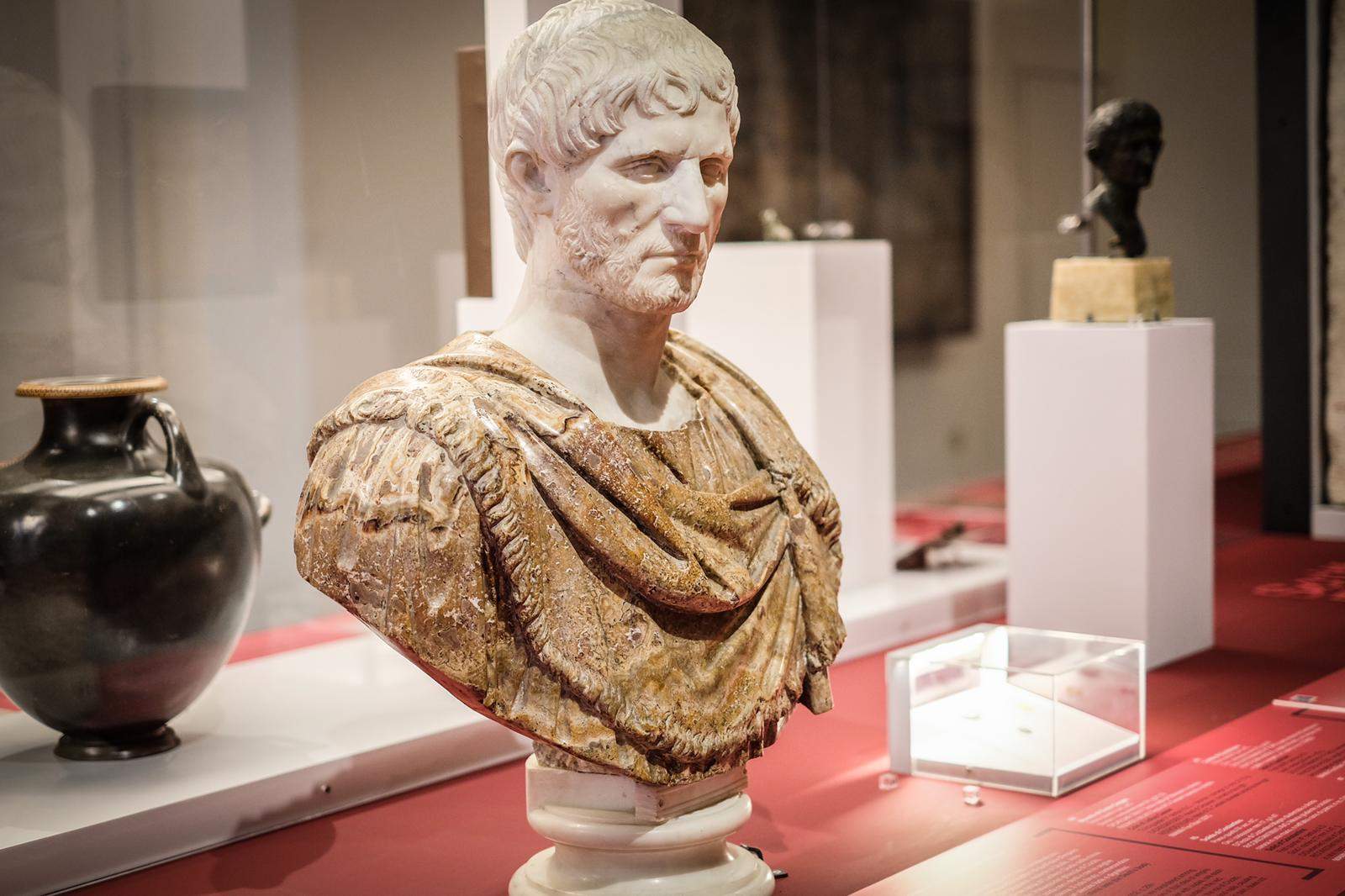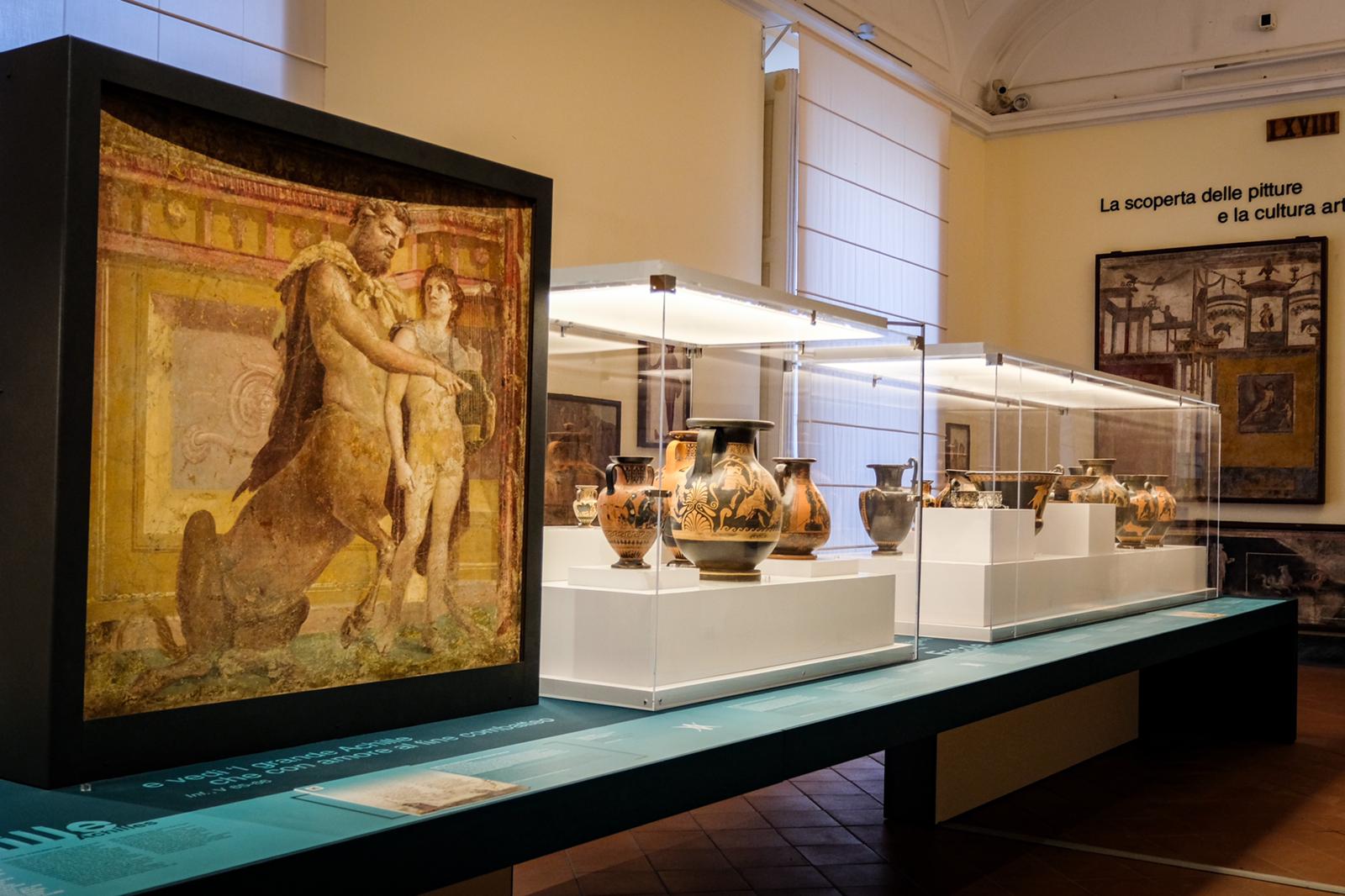Naples, an exhibition at MANN on Dante's mythological themes in the museum's collection
It is an ideal link between classical iconography, medieval culture and contemporary sensibility the exhibition"Divine Archaeology. Mythology and History of Dante’s Comedy in the MANN Collections," scheduled at the National Archaeological Museum in Naples from Dec. 6, 2021 to May 2, 2022. In the exhibition curated by Valentina Cosentino (archaeologist/MANN Scientific Secretariat), 56 artifacts link the Supreme Poet to ancient authorswho, through the language of art, narrated the legendary figures in Alighieri’s poem: the exhibits of “Divine Archaeology” let the visitor imagine the Florentine writer next to vases, statues, reliefs, and coins, which he certainly did not see with his own eyes, although, with the power of words, he managed to recreate their visual suggestion.
Thanks to the network with the Federiciano Athenaeum, the exhibition also features high-resolution photographic images of the miniatures found in some medieval manuscripts of Dante’s poem: the codices, which enter the international database of the Illuminated Dante Project, allow the exhibits to be compared with the 14th-century reinterpretation of classical culture. Through QR codes, placed next to the digitizations of the miniatures, one can browse the entire witness from which the decoration is taken. In addition, to complement the exhibition itinerary, also available via QR-code is a video narrative, edited by Professor Gennaro Ferrante and researchers Fara Autiero and Serena Picarelli, of Dante’s journey to the afterlife through the most beautiful medieval miniatures of the Comedy. The exhibition is divided into two sections.
 Setting up the
Setting up the Setting up the
Setting up theThe first section: Tales of Myth.
Divine Archaeology starts with a focus on myth in medieval culture and in the tercets of the Comedy. Five charactersare thus narrated: Achilles, Hercules, Theseus, Aeneas, and Odysseus. Achilles, mentioned several times in the Comedy, does not have, in Dante’s verses, a dedicated narrative. Digressing from the classical tradition, which had celebrated the Pelid for his exploits and his unique vulnerability in the heel, the Florentine poet glimpses Achilles in the circle of the lustful, where he is condemned for his multiple loves (Deidamia, Briseis, Penthesiliea, Patroclus). On display is completed what Dante left implied in his literary hint, related to the more human aspect of Achilles: possible to admire, in the exhibition, the 4th style fresco in which the Greek hero is educated by the centaur Chiron; anamphora (550-500 B.C.E.) with depiction of Achilles and his cousin Ajax while playing dice, perhaps questioning fate; the pelike (wide-mouthed vase/375-350 B.C.- from Ruvo) with Achilles meeting his mother Thetis in a sea cave after the death of Patroclus; the pelike (510-500 B.C.E.) depicting the contention over the attribution of the Pelid’s weapons.
Heracles, the invincible: like Achilles, Heracles is also mentioned several times by Dante, who mentions, even indirectly, his twelve labors. The exhibits recount every aspect of the myth and its variants: in this regard, more than seventy iconographic patterns are known, ranging from the Archaic to the late Roman age. On display, a number of splendid artifacts are selected: among them, it is worth mentioning the two silver cups (from the House of the Menadro in Pompeii, second half of the first century B.C.) with the representation of all the twelve labors;the red-figure crater (490-480 B.C., formerly the Shelby White collection) with Hercules wearing the skin of the Nemean lion; the three black-figure amphorae, datable between 575 and 500 B.C., with Heracles and Geryon; and the hydria (530-510 B.C., attributed to the painter of Priam) with apotheosis of Heracles. On display, thanks to images from a medieval manuscript (second quarter of the 14th cent.) preserved in Hamburg, is the presentation of the miniature en bas de page with Hieron’s landing on the brink of the Malebolge.
Theseus the liberator: Minos, the king of Crete, builds a labyrinth, locking up his son, half-man, half-bull, in it. To feed him, the ruler imposes a tribute of fourteen young men and women on Athens. Theseus, tired of this anguish, comes to the island; with a stratagem he manages to kill the Minotaur, emerging from the labyrinth. As the victor, he leaves Crete and takes his lover Ariadne with him, only to abandon her in Naxos. In the Comedy, rather than the hero’s exploits, which are remembered only in passing, the characters connected with him acquire greater prominence: Minos and the Minotaur. Ancient art, on the contrary, illustrates almost every moment of the myth in a kind of story board: thus, Theseus’ life, like a movie, outlines the character’s lights and shadows. On display, not to be missed are the IV-style fresco with Ariadne handing the thread to Theseus (the find belongs to the MANN collections and comes from the House of Ancient Hunting in Pompeii); the two black-figure amphorae, as well as the oinochoe, with Theseus and the Minotaur (the three artifacts date back to 550-500 BCE.C.); the painting on marble (early 1st century C.E.) depicting Theseus with a centaur (the work is part of the MANN’s holdings and comes from Herculaneum). The iconographic comparison with medieval manuscripts is represented by digitizations of two miniatures: the first with the Minotaur biting his hands at the arrival of Dante and Virgil and the second with the two poets before Minos judging souls. The witnesses presenting these splendid decorations come from the Bodleian Library in Oxford and the Biblioteca Nazionale Centrale in Florence, respectively.
The “pious” Aeneas, who becomes immortal through the Roman elaboration of the myth. Pietas, his main virtue, is for the ancients not compassion or mercy, but religious devotion, love for the values of country and family. And it is precisely pietas that will make it possible for him not only to found Rome, but also to define a new lineage capable of changing the face of history. In the exhibition, a number of artifacts tell the myth of Aeneas, interweaving figurative representation with Dante’s verses: the black-figure amphora (510-490 B.C.) and terracotta (first half of the 1st century A.D.) with Aeneas and Anchises, as well as the honorary inscription with Aeneas’ praise (first half of the 1st century B.C.).
The multifaceted ingenuity of Odysseus: “I am Nobody.” In this famous phrase can be summed up one of the main characteristics of Odysseus, who is not only the hero of a thousand deceptions, but is above all the decisive warrior in the ten-year conflict against Troy. Odysseus sets out from Ithaca where he leaves his wife and child to fight alongside Agamemnon at Troy. His many adventures include such famous episodes as the theft of the Palladium (the sacred statue of Athena) and the unmasking of Achilles at Syrus; along with him is often the trusty Diomedes, who also accompanies him, as the second tongue of a single flame, among the fraudulent advisers in Inferno, XXVI, according to Dante’s revision of the myth. A splendid miniature, digitized from a manuscript preserved at the Château de Chantilly Library, opens this segment of the exhibition dedicated to the hero who overcame the Pillars of Hercules: here Francesco Traini and workshop depict Dante and Virgil’s encounter with Ulysses and Diomedes enveloped in flames. Not only that: not to be missed is the en bas de page drawing that appears in another medieval witness, kept at the National Library in Naples. In this case, there is a depiction of Ulysses’ shipwreck outside the Pillars of Hercules. Also rich, of course, is the selection of artifacts presented to the public: among them, the famous marble statue of Diomedes (1st century AD), which belongs to the MANN Collections and comes from Cumae; the painted plaster in the 3rd style with the Trojan horse (from Pompeii, first half of the 1st century AD, belongs to the Museum’s collections); and the Panathenaic amphora with Palladius’ rape (450-400 BC).


Second section: The characters of myth and history.
A gallery of portraits, both real and imaginary, encountered by the Supreme Poet. The exhibition follows an itinerary of the imagination, with forays into Dante’s present, tracing faces and characteristics of monsters, gods, figures from ancient history, writers and poets, whom Alighieri forever carved into his own tale. It starts with monstrous creatures: the digitization of the illuminated antiporta of a manuscript (Bibliothèque Nationale de France/first half of the 15th century), presents visitors with the topography of the Inferno. MANN’s exhibits offer “visual evidence” to the celebrated protagonists of Dante’s Inferno: bronze plaques with Centaur and Centauress (1st cent. CE), in dialogue with both the image of a tabular miniature depicting the centaurs as they threaten Dante and Virgil (the witness comes from Budapest and dates to the fourth decade of the 14th cent.), as well as with a miniature with a similar subject in a manuscript in the Biblioteca Medicea Laurenziana; not to be missed, again, is the fresco-painted plasterwork with the head of Medusa (the artifact comes from the Villa of the Papyri in Herculaneum and belongs to our collections), in comparison with a similar theme in a miniature en bas depage digitized from a manuscript preserved in Hamburg.There is no shortage of focus on the Harpies, thanks to the cross-reference between a red-figure kalpis (480-470 BC, Kleophrades painter) and the miniature taken from a witness in the Bodleian Library in London. Finally, a number of Greek and Roman bronze coins (4th-2nd centuries B.C.), which come from the St. Theresa Necropolis, are on display.
From monstrous creatures to gods: On display at the MANN, possible to admire thebronze Apollo, which comes from the domus ofthe same name in Pompeiiand belongs to the Museum Collections, put in dialogue with the illuminated frieze of Dante crowned a poet by Apollo (the depiction is digitized from a manuscript kept at the Historical and Civic Archives/Trivulziana Bilbioteca); the bronze Fortuna Stante (1st cent. AD) is linked to the tabular miniature with the Wheel of Fortune in a medieval codex kept in Budapest. Still, present on display are thematic focuses on Muses, Mars, Venus and, of course, Hades, always with reference to the medieval fortune of Dante’s characters in the illuminated manuscripts of the Comedy.From myth to history: the characters of the past are inserted by Dante into a providential design linking the Roman Empire to the figure of Christ Despite the fact that in Dante’s sources the judgment of Caesar had generally been unfavorable, the poet associates the birth of Christ with his activity politics, consecrating him as the first true emperor and placing him in the “noble castle” of limbo where the spirits promoting that magnanimity and nobility of spirit that transcends the division between Christians and pagans are to be found.
Among the exhibits on display are a coin of Julius Caesar(third quarter of the 1st century B.C.), in dialogue with Caesar’s triumph in a digitized miniature from a manuscript in the Bibliothèque de l’Arsenal in Paris; also, a Loricated statue of Trajan (early 2nd cent. A.D.) that ties in with the decoration of a codex that comes from the Schulbibliothek des Christianeum in Hamburg; finally, a solid of Constantine and one of Justinian (the former dates to the 4th, the latter to the 6th century A.D.). The exhibition closes with a tribute to the value of philosophy and poetry as a perennial trait d’union between the arts: included in the display are marble busts of Homer (2nd cent. AD), Socrates (1st cent. AD), Pseudo-Seneca (1st cent. AD), the bronze bust of Democritus (1st cent. BC) and the famous relief with Orpheus and Eurydice (late 1st cent. BC/early 1st cent. AD). The miniature with Dante in the lineup of poets, digitized from a manuscript (14th cent.) in the Girolamini Library, “canonizes” this consensus of wisdom between the ancient past and medieval culture. Finally, an integral part of the display is the“Divine Archaeology Podcast” cycle, which, an absolute novelty in the Museum’s production, is produced by Archeostorie and NW.Factory.media with the contribution of Scabec: through QR codes it is possible to access evocative tales of Dante’s characters and myths.
 |
| Naples, an exhibition at MANN on Dante's mythological themes in the museum's collection |
Warning: the translation into English of the original Italian article was created using automatic tools. We undertake to review all articles, but we do not guarantee the total absence of inaccuracies in the translation due to the program. You can find the original by clicking on the ITA button. If you find any mistake,please contact us.





























